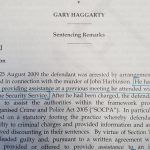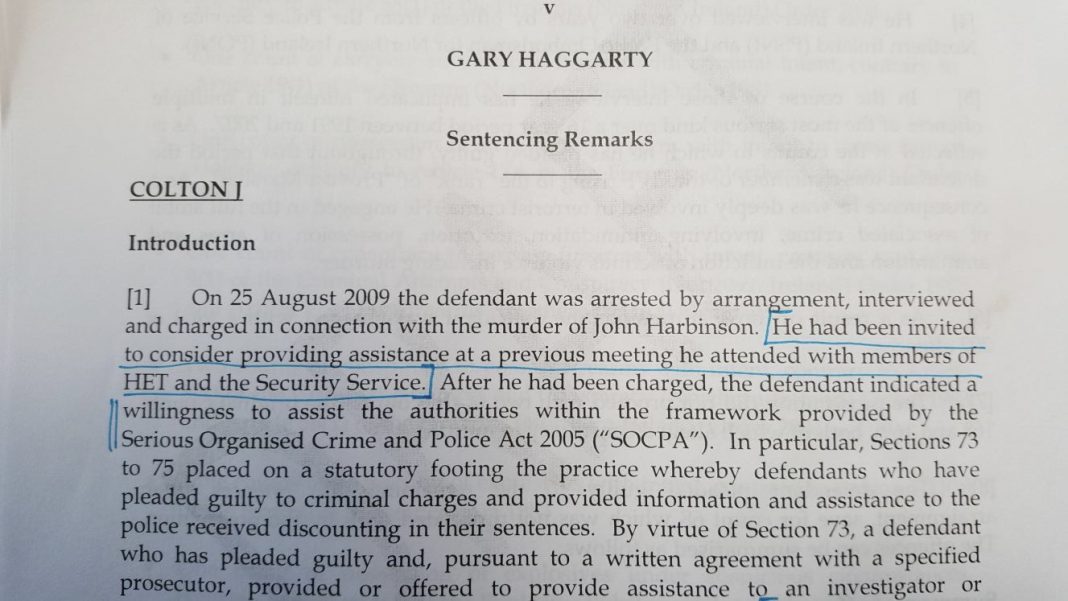RFJ attended at court for the conclusion of the criminal proceedings in relation to Gary Haggarty. The sentencing today marked an important and difficult day for the families, but it is by no means the conclusion of their campaign to achieve genuine accountability for the harms committed against them. Our earlier blog pieces on this case show the long and damaging process the families have been put through to get to this stage.
The full Summary of sentencing can be found here Haggarty Sentencing Comments. Although Haggarty pleaded to over 500 offences, all serious in nature, the murders he was involved in were the focus of this hearing. Judge Colton’s sentencing remarks point to the ‘devastating and permanent impact upon the family members’, quoting from the victim impact statements he received. As he went through the murders of John Harbinson, Peter McTasney, Sean McParland, Sean McDermott, Gary Convie and Eamon Fox, he referred to accounts given by the witnesses who had survived the attacks, all of which were moving and emotional.
He also commented upon the anger which the victims expressed in their statements about the involvement of police officers in the crimes, the failure to protect and prevent attacks upon many the victims and the failure to rely upon Haggartys evidence to prosecute two particular police officers. It is unlikely this anger will have diminished following today’s hearing, which simply reinforced our opinion that there is sufficient evidence available for the PPS to charge and run cases if they wished to do so.
For example, in relation to the murder of Sean McParland, the Judge commented that ‘the defendant’s description of what took place at the scene tallies with the account given by young Michael Monaghan’, the nine-year-old boy present when his grandfather was shot. Despite each account corroborating the other, the PPS have refused to initiate proceedings against any of the other people named by Haggarty as involved in this murder, many of whom were also informants.
Further trials would afford victims families greater insight into what information was exchanged between those carrying out the murder and their RUC Special Branch handlers. After spending years debriefing Haggarty, advising families he had credible and useful information to provide and piling resources into this case, the PPS decision to rely upon Haggarty for a solitary prosecution against a single loyalist gunman feels to many like the conclusion of a sham process.
The judge made clear that Haggarty ‘occupied a prominent leadership position in the UVF throughout this period and actively directed its activities in addition to directly participating in many of its operations’. It is entirely reasonable that families seek the answer to the obvious question of who was directing Haggarty, a known informant. One potential clue to this may lie in how Haggarty came to be an assisting offender. The Judge states in his sentencing remarks that ‘he [Haggarty] had been invited to consider providing assistance at a previous meeting he attended with members of the HET and the Security Service.’

The role that MI5 had in relation to the activities of Haggarty and others, and their interest in these proceedings is yet to fully come to light. This case led to a change in HET policy, with any cases with investigative leads being moved to PSNI, so their presence at this meeting with Security Services requires further probing.
A Judicial review has been initiated and it is hoped that some of these questions, and questions of the then Policing Board, may yet be answered.
After setting out the starting points for each of the murders, which varied between 18 and 35 years, Judge Colton worked through a process of discounting the sentences. Haggarty was given a reduction on three grounds,
- for the assistance he has given under his agreement with the PPS,
- for information he provided to authorities whilst he was an informant or CHIS
- for pleading guilty rather than having a trial
The benefit to RUC Special Branch and MI5 of Haggarty pleading guilty is clear. In relation to the agreement with the PPS, Haggarty is required to give full information about the activities he has been involved in, and the PPS must provide a report about how useful they believe this information to be. Judge Colton quoted from this report stating:
“The defendant has given a vast volume of information in respect of his own criminality and that of others. He has a very good memory and the level of detail in his accounts is remarkable given the significant number of incidents in which the defendant has been involved and the time that has passed since the incidents occurred. The defendant is robust and resistant to challenge and on the whole his accounts have been clear and consistent.”
Haggarty has complied with his part of the agreement and seems to have the hallmarks of a good witness. The judge went on to make clear that many of the convictions relating to Haggarty were as a direct result of his own evidence and that ‘without these admissions there would have been insufficient evidence to sustain a prosecution against him’.
It seems perverse that Haggartys evidence is good enough to convict him, and potentially other loyalists, but deemed to fall short when it comes to RUC Special Branch Officers.
Haggarty also received credit for the information he had provided to ‘the authorities’ whilst he was working as an informant between 1993 and 2005. Having been paid a substantial amount of money, enabled to rise to the top of the UVF and maintain a criminal empire, protected from investigation for planning and carrying out several murders, Haggarty now receives a lesser sentence because he did all of this whilst employed by the State and told them about what he was doing as he went along.
The judge made mention of occasions when Haggarty gave information which allowed the police to mitigate the threat against people. What wasn’t mentioned were the occasions where the police received information and failed to act, or where it is suspected they assisted in the targeting of individuals. There is a clear need for this to be addressed.
Haggarty’s sentence was discounted by 75%, then a further 25%. This takes the time he has to serve down to 6 and half years. He has served roughly 3 years and 4 months on remand. Defence Counsel made clear he will be applying to the Parole Commissioners for release, which is unlikely to take very long. At that point he will be free to build a new life under a new identity, assisted by the State.
When it is said by the State that there are no resources to deal with legacy issues, be under no illusions. This is only the case when it comes to families seeking inquests, victims seeking information and investigations, or needing therapeutic and practical assistance. For those like Gary Haggarty who can say which individuals and agencies were involved in planning and directing State violence, all manner of inducements are available to make sure hidden forces stay hidden.









